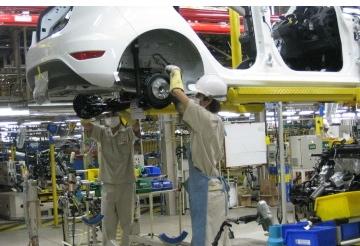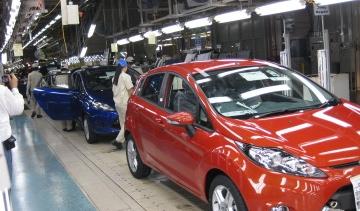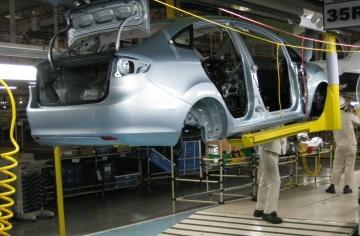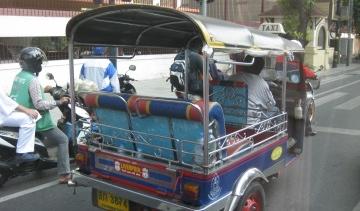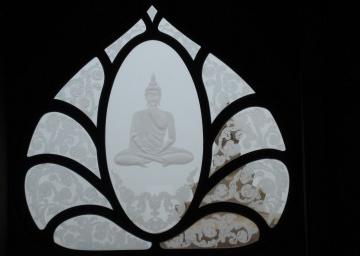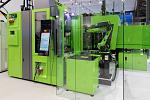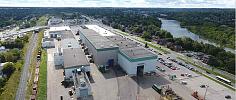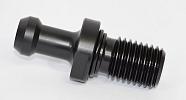- FMA
- The Fabricator
- FABTECH
- Canadian Metalworking
Thailand: A New Asian Tiger?
Thailand’s manufacturing base is growing rapidly, but poor domestic machinery supply base spells opportunities for Western suppliers
- January 10, 2011
- News Release
- Metalworking
The first thing you notice in Bangkok, capital of Thailand, are the traffic clogged streets: cars and trucks compete for space with motorcycles, “tuk-tuks” (motor scooters turned into three-wheeled taxis, with a bench in back for passengers) and “songthaews” (pickup trucks with two rows of benches in the rear that serve as mini-buses). Once you get used to the traffic, you start to notice there are pictures and statues everywhere of Buddha (Thailand is majority Buddhist) and King Rama IX (also known as Bhumibol Adulyadej, Thailand’s long-reigning constitutional monarch).
Bangkok itself offers a haphazard mix of architecture, with ultramodern commercial and residential buildings located near shacks with tin roofs. The mix of poverty and wealth is startling, but typical of a developing country. The weather in Bankgok—as in much of the rest of the country—was overwhelmingly hot and humid.
We weren’t in Thailand as tourists, however; our press visit, sponsored by the Thailand Board of Investment, was focused on industrial facilities as part of the Machinery and Metalworking Media Tour. Thailand is a rapidly expanding manufacturing hub that might offer opportunities for Western firms selling machine tools and other equipment.
With an overall population of 67 million people, Thailand’s labour force is 38.43 million strong. Unemployment stands at a mere 1.5 per cent.
Thailand’s biggest selling points: a hard working, well educated population, good infrastructure and a relatively well functioning, democratic political system. The country’s goal: to join the first rank of the so-called Asian Tigers—economic powerhouses such as South Korea, Japan and China that epitomize manufacturing prowess.
A growing economy
Thailand’s economy grew an average of four per cent annually from 2000 to 2008 then contracted 2.8 percent in 2009 when the global recession hit. The country bounded back quickly, however, and GDP growth stood at 10 per cent for the first half of 2010. Total GDP in 2010 came to US $584.76 billion and is expected to rise to $615 billion in 2011.
For the first nine months of 2010, exports grew by 23 per cent while imports grew by 35 per cent. Leading Thai exports include machinery and mechanical appliances, vehicle parts and accessories and electronic appliances.
Automotive in particular is a growth sector. Thailand factories produced 1.4 million vehicles in 2008, a figure the Thai Auto Institute estimates will leap to 2.1 million in 2014. Thailand is now the largest vehicle producer in Southeast Asia. The country also has a sizeable machinery and metalworking sector, comprising of 400,000 workers in 50,000 different companies. Moulds and dies are big business as well; Thailand’s mould and die sector is valued at US $2.6 billion, a total forecast to double by 2013. There are currently 1,100 factories making moulds and dies in Thailand, primarily for automotive and electronics/electrical appliance firms.
Thanks to rapid industrialization, Thailand has a growing need for machine tools.
Growing need for machine tools
“Growth in Thailand’s automotive and electronics/electrical appliances industries are expected to fuel demand for modern machine tools. Automotive and auto parts firms are the biggest buyers of machine tools, purchasing 35 per cent of the domestic market. The supporting metalworking industry follows with 27 per cent while the electronics/electrical appliance industry buys 14 per cent. With a limited number of domestic enterprises specializing in the manufacture of machine tools, most of the demand is currently met by imports which totaled US $1.525 billion imported in 2007,” according to the latest information from the Thailand Board of Investment (BOI).
Moulds and dies are also in high demand, according to the BOI, “Local mould and die manufacturers are only partly able to meet the increasingly sophisticated demands of Thailand’s downstream industries, leaving a significant opportunity … for higher quality mould and die imports from foreign manufacturers.”
Thailand boosters like to contrast their nation with China. Thai officials insist that intellectual property is respected in their country, rule of law prevails and the government is considerably less violent and authoritarian than in China.
During a press conference, David Nardone, president and CEO of the Hemaraj Land and Development Public Co. Ltd., did concede that there was some “lingering unrest downtown”—a reference to recent political turmoil in Bangkok. This turmoil involved a group of protesters called the “Red Shirts” but was largely over, Nardone insisted.
In any case, Thai officials prefer to stress entrepreneurial spirit over political ideology.
“What moves Thailand is the private sector. Not politicians,” noted Chackchai Panichapat, executive director Amata Corp.
Industrial estates—massive swaths of land that encompass scores of companies and sometimes residential and commercial sections—are a prominent feature in Thailand.
The Hemaraj Land and Development Public Co. Ltd. is one of the more prominent firms in this field. Said firm runs six industrial estates, covering 13,000 acres in total. Some 450 customers operate businesses in these estates, including 150 automotive firms. Total estate employment tops 80,000 people.
The flagship Hemaraj Eastern Seaboard Industrial Estate and the Eastern Seaboard Industrial Estate (Rayong) make up what Hemaraj calls, “The Detroit of the East”. The estates boast 113 automotive OEM parts and components manufacturers and production facilities from 15 of the world’s top 25 auto suppliers. Clients include Ford, Mazda, GM and Suzuki.
Ford and Mazda operate a joint venture in the Eastern Seaboard Industrial Estate (Rayong) called AutoAlliance Thailand, which produces one-ton pickup trucks and sedans for the local market and export. We visited the AutoAlliance plant and found it extremely clean and brightly lit. A long line of cars on blocks slowly slid by on an auto assembly line, as workers in khaki-coloured uniforms added parts and features. There were countless, man-sized fans set up along the assembly line, to ameliorate the effects of the intense heat.
The AutoAlliance Thailand was launched in 1995, with an initial startup production capacity of 130,000 units. This has been increased to the current rate of 175,000 units a year, 30 percent for domestic sale and 70 percent for export. The AutoAlliance facility produces the Ford New Ranger, Mazda BT 50 and Ford Everest and handles a variety of manufacturing processes including stamping, body work, painting, engine assembly, trim and final inspection.
Ford and Mazda clearly have faith in the AutoAlliance Thailand facility: in 2007, the two companies announced plans to invest an extra US$500 million to expand operations and open a new passenger car plant. This brings Ford and Mazda’s total investment in AutoAlliance Thailand to over US$1.5 billion. A stone was laid for the new plant in June 2010, with a projected opening date of 2012. The new plant will have an initial production capacity of 150,000 units annually.
GM Thailand also resides in the Eastern Seaboard Industrial Estate (Rayong). Established in 1993, the GM locale boasts a 190-acre property and employs over 2,000 people.
“We rely more on people than automation,” noted Brad Cole, from Thailand GM manufacturing engineering, in a refrain we would hear more than once.
Italian steel manufacturing giant Danieli has operated a branch in the Eastern Seaboard Industrial Estate (Rayong) since 2005. Danieli Far East Co. designs and manufactures equipment and parts for steelmaking facilities around the world, including long products, flat products, sections and bars. The facility employs 2,200 people, roughly 97 per cent of whom are Thai.
While Danieli also relies on the human touch more than automation, the company does use CNC machines from Italy, German, Taiwan and Japan.
The company avoids buying machine tools made in China: “Because our equipment is so high quality … we need higher and better quality machines,” explained Danieli Far East CEO Boonnarg Mockmongkonkul. “Some of our customers have contracts where they say they don’t want any equipment from China.”
The leading developer of industrial estates in Thailand is a company called the Amata Corp. (the name means “eternal”). Launched in 1989, Amata specializes in what it calls “perfect cities”.
The corporation’s15 subsidiaries and dozens of joint ventures offer support such as ready-built factories, power, water, waste water treatment, broadband internet, vehicle leasing, housing, shopping, health clinic, schools, and restaurants.
Amata currently runs three massive industrial estates: Amata Nakorn in Chonburi, Amata City in Rayong province and Amata Vietnam.
Established in 1989, Amata Nakorn is the company’s largest estate, spread out over 3,020 hectares (7,549 acres) in a location close to Bangkok. As of August 2010, some 458 factories employing 140,000 workers operated in Amata Nakorn, with 30 factories under construction. More than 60 per cent of firms are Japanese, while Thai firms account for 17.36 per cent of the total. Companies in Amata Nakorn work in steel/metal/plastics, automotive, electronics, chemicals, consumer goods, etc.
Amata City, meanwhile, was launched in 1995 and features 97 factories on 1,603 hectares (4,007 acres). An additional 20 factories are under construction. A total of 25,000 workers currently toil in the estate. Japanese firms account for 28.70 per cent of the companies in Amata City while Thai firms make up 20.87 per cent. Some 32.17 percent of estate firms are involved in steel/metal/plastics, 24.35 per cent are involved in automotive, with the remainder in electronics, chemicals and healthcare products.
Amata Vietnam, meanwhile, was launched in 1994. It has 24,300 workers who labour in roughly 90 factories dealing in chemical/plastic/paint, textiles, auto parts, etc.
Manufacturing in Thailand
Companies with operations in either of Amata’s Thailand estates include BMW, Bridgestone, Toyota, Mitsubishi Electric, Mitsubishi Elevator, Hino Motors, etc.
Peter Wolf, the German managing director of BMW Group Thailand, showed us around a BMW auto manufacturing plant in Amata City. The plant was primarily building cars for export to Malaysia and Indonesia. The BMW Thailand facility had 180 employees and capacity for 6,000 units per year, based on a one-shift day. The factory was very clean and well lit, with an extremely orderly warehouse. Automation wasn’t used much, due to low volumes, said Wolf. The workforce, he added was 100 per cent Thai, but for three expatriates, presumably including himself.
Asia Precision, based in Amata Nakorn Industrial Estate, was one of the more intriguing places we visited. A tier one and two precision metal component manufacturer, Asia Precision was founded in 1995 with a workforce of 15. The plant rapidly expanded and moved to Amata Nakorn in 2002. The workforce currently numbers 700 employees, toiling in a small cluster of factories.
Asia Precision does cold forging, precision machining, gear making and induction hardening. The company primarily makes parts for the automotive, camera, compressor, machinery, medical, office automation, telecommunications and aerospace sectors. Customers include Canon, Denso, Eagle, Emerson, FCC, Summit Mitsuba, Honda, Suncall, Toyoda. Over half of the company’s clients are in the vehicle manufacturing sector.
The workday at the Asia Precision plant we visited begins at 8 am when staffers gather in the canteen to sing the Thai national anthem. This is sometimes followed by meditation and a reading of the King’s writings. A communication session, in which day-to-day workplace issues are discussed, is also part of the regular schedule, said Asia Precision president, Apichart Karoonkornsakul.
Almost half the personnel at Asia Precision are female, which is unusual in Thailand, where workforces are predominately male. The facility is “lady friendly” explained president Karoonkornsakul. Women, he said, make very good workers because they tend to be more patient and delicate than their male counterparts.
While there’s no union at Asia Precision, the president insisted there’s “never any labour issues here.” Factory floor employees are represented by officials who discuss concerns with management.
Staff amenities abound at Asia Precision: among other things, the plant includes a music room (complete with drums, electric guitars and amplifiers) where employees can blast eardrums and rooms for massage, meditation and ping-pong. The meditation room contains reclining chairs and is a popular site after lunch, said Karoonkornsakul. The factory also runs a farm, outside of Bangkok, where workers are welcome to plant rice and catch fish. The farm allows employees keep in touch with their bucolic backgrounds, as many of them hail originally from rural areas.
Asia Precision boasts over 300 CNC machines and other pieces of equipment. The roster includes CNC turn-mill centers and lathe turning machines from Wasino and Mori Seiki, CNC lathes (bar turning) from Miyano, CNC swiss lathe turning machines from Cincom and Star, vertical machining centers from Makino, Matsuura and OKK, horizontal machining centers from Mori Seiki, shaving machines from Mitsubishi, cylindrical grinding machines from Toyoda and Paragon, surface grinding machines from Okamoto, centerless grinding machines from Paragon and Palmary, cold forging presses from Chin Fong, CNC rolling machines from Nachi, wire cutters from Mitsubishi, etc. For measurement and quality control, Asia Precision uses a CMM from Mahr, among other instruments.
The facility showed a great deal of Japanese influence. Asia Precision has borrowed elements of the Toyota Production System (TPS), with a visual control board and kanban system. The plant offers training in TPS as well.
Like other Thai plants, there were countless statues and pictures of Buddha and the King at Asia Precision.
“We respect the King very much,” said Karoonkornsakul.
As proof, he noted that all new employees receive a book featuring the monarch’s writings when they start at the plant. The King is seen as a guiding light on both how to run a business and be a good member of society, he explained.
In such a regal environment, it seemed fitting that our press group was taken on a side-trip to an actual castle that’s being built on the grounds of the Amata Nakorn estate. The castle keeper is one Vikrom Kromadit, founder and CEO of the Amata empire.
By turns an entrepreneur, philanthropist, philosopher, author, self-help sage and master builder, Kromadit made his fortune establishing industrial estates. Chinese by descent, Kromadit is the eldest of 22 siblings. His father was a sugarcane farmer.
In 2007, Forbes magazine listed him as the 27th wealthiest man in Thailand, with a net-worth of $170 million. Kromadit slipped to 34th place in 2008, then fell off the list altogether in 2009. He remained off-list in 2010 as well. Still, it’s safe to say he’s a very rich man.
Kromadit has penned several autobiographical tales, one of which forms the basis of a popular Thai TV soap opera called “Fai Amata” (which translates to “Eternal Flame”).
And now he’s building himself a castle, at a reputed personal cost of US $50 million. While the castle was under construction when we visited, it still had the ability to awe. The massive structure was several stories high, complete with imposing, khaki coloured walls, turrets and interior rooms the size of soccer fields.
During a social dinner, Kromadit insisted he didn’t want the castle all to himself. He said he planned to fill the castle with artists and other creative types. Kromadit also entertained us with tales of his colourful past and told us about a motor tour he wanted to undertake in Southeast Asia.
At the table, Kromadit didn’t talk much about business. In an interview published in February 2009 in Power magazine, Kromadit was more considerably explicit about his corporate goals: “I would like to have my own city. My own territory. My own empire. I would like to be like a little king, but I’m not there yet,” he told the magazine.
In a similar manner, Thailand isn’t quite at the level of the top Asian tigers, but, like Amata Castle, it is rapidly rising to prominence in the manufacturing field.
subscribe now


Keep up to date with the latest news, events, and technology for all things metal from our pair of monthly magazines written specifically for Canadian manufacturers!
Start Your Free Subscription- Industry Events
MME Saskatoon
- May 28, 2024
- Saskatoon, SK Canada
CME's Health & Safety Symposium for Manufacturers
- May 29, 2024
- Mississauga, ON Canada
DiPaolo Machine Tools Open House 2024
- June 4 - 5, 2024
- Mississauga, ON Canada
FABTECH Canada
- June 11 - 13, 2024
- Toronto, ON Canada
Zoller Open House & Technology Days 2024
- June 12 - 13, 2024
- Ann Arbor, MI













